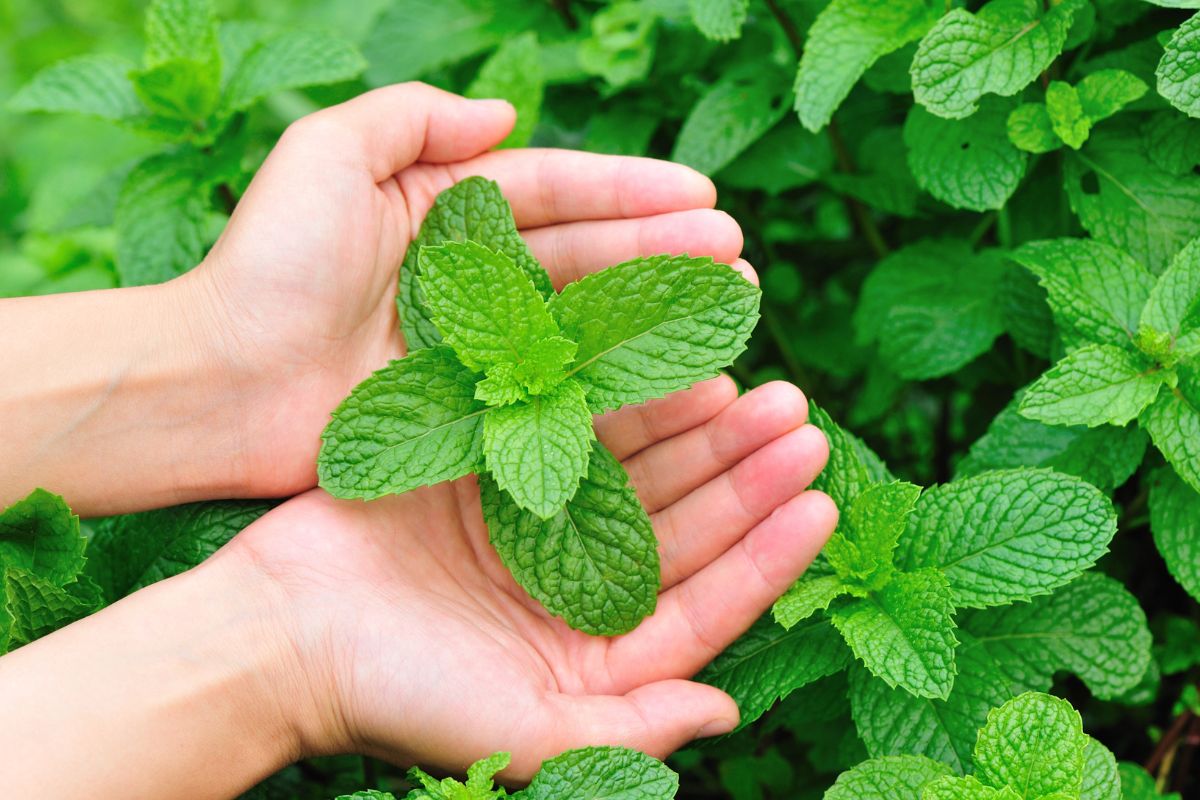Have you ever had a warm cup of peppermint tea when you had a stomachache or felt bloated? If so, you’ve probably already experienced a little bit of this plant’s power. Peppermint is one of those herbs that almost everyone knows, but few people truly understand the full extent of its benefits. It shows up in gardens, recipes, cosmetics, and of course, in those traditional teas that have been passed down through generations. But what many people see as just a fragrant little green leaf actually holds an incredible arsenal of medicinal properties.
The truth is, peppermint goes way beyond what we usually think. It helps with digestion, relieves pain, clears up your breathing, fights bad breath, and even has a calming effect that makes a big difference on stressful days. And it’s not just old wives’ tales. Many of these effects have been studied and scientifically proven — which shows that our grandmothers knew exactly what they were doing when they recommended that magical tea.
In this article, I’m going to tell you exactly what peppermint is good for, how it can truly boost your health, and show you easy ways to include it in your daily life. Let’s explore together the many benefits of this amazing plant that deserves a spot in your garden, your teacup, and definitely in your self-care routine. Come with me!
🌿 Grandma’s Peppermint Has Science Behind It!
Who hasn’t had that classic peppermint tea made by a grandma or some wise aunt in the family? It was almost a ritual: just mention a stomachache, nausea, or even anxiety, and the kettle was already on the stove. As a kid, I thought it was just a comforting gesture, maybe a bit of superstition. But over time — and with a bit of curiosity — I realized there was deep wisdom behind that simple act.
Peppermint, humble as it may seem, is highly respected in herbal medicine and even in conventional healthcare. It contains active compounds like menthol, rosmarinic acid, and flavonoids that have anti-inflammatory, analgesic, calming, and digestive effects. These compounds are what give peppermint its refreshing feel and powerful healing potential. So, that “grandma tea” actually has real science backing it up.
In fact, a study published in the Journal of Clinical Gastroenterology found that peppermint oil can help relieve symptoms of irritable bowel syndrome. Other studies have proven its bronchodilator effects, which help people suffering from conditions like bronchitis and sinusitis. It’s incredible to see how modern science confirms what past generations already knew through lived experience: peppermint works!
And perhaps the most beautiful part of it all is this connection between traditional wisdom and modern science. It doesn’t have to be one or the other — they can go hand in hand. The knowledge passed down from our elders, shared with so much care, finds validation in research. When we understand this, we begin to appreciate even more the power of medicinal plants we have access to, sometimes right there in a pot on the kitchen windowsill.
✅ So, What Is Peppermint Good For?
Now it’s time to answer the big question. And trust me — the list is impressive!
1. A Digestive Ally
Feeling heavy after a big meal? Peppermint to the rescue! It stimulates bile production and helps digestion flow smoothly. It also reduces gas, cramps, and that uncomfortable bloated feeling. A cup of tea after lunch can work wonders — I’m not kidding.
2. Relieves Respiratory Issues
Got a stuffy nose, cough, or sinus problems? Menthol — the main component in peppermint — acts as a natural decongestant. Inhaling the steam or sipping a hot peppermint tea can bring real relief. It’s like nature’s version of VapoRub!
3. Natural Calming Effect
Feeling anxious or struggling to fall asleep? Peppermint has gentle sedative properties that help calm the body and mind. A cup of tea in the evening is a lovely way to unwind and slow down after a hectic day.
4. Pain Relief
Peppermint essential oil, especially from peppermint (Mentha × piperita), is great for headaches, migraines, and sore muscles. I’ve personally used it, diluted, on my temples — and wow, what a difference!
5. Freshens Breath and Fights Bacteria
That refreshing sensation isn’t just for show. Peppermint has antiseptic properties that fight bad breath and promote oral health. That’s why it’s in nearly every toothpaste out there!
🌱 Types of Peppermint: What’s the Difference?
Did you know there are several types of peppermint, each with its own properties and uses? Most people think it’s all the same, but that’s not quite true. The two most common types are spearmint (Mentha spicata) and peppermint (Mentha × piperita). Spearmint has broader leaves and a milder flavor — it’s the one your grandma probably used in tea. It’s great for daily use, aids digestion, and helps relax the body. Peppermint, on the other hand, is more intense and packed with menthol — you can really feel that icy sensation!
The difference goes beyond flavor and scent. Peppermint is widely used in essential oils, especially in aromatherapy and natural cosmetics. It has strong analgesic effects and is excellent for muscle pain, migraines, and respiratory issues. But because it’s more concentrated, it should be used with care — it may irritate the skin or not be suitable for pregnant women or young children. Spearmint is more versatile, perfect for fresh use in teas, recipes, or calming compresses. Knowing these differences helps you use peppermint more mindfully and get the best out of each type.
🍵 How to Use Peppermint in Your Daily Life
Now that you know what peppermint is good for, let’s talk about practical ways to use it:
Peppermint Tea
A true classic. Just boil water, toss in some fresh (or dried) leaves, cover, and steep for about five minutes. You can drink it hot or cold, plain or with lemon and honey. It’s comforting and healing.
Steam Inhalation
For congestion, boil water with peppermint and inhale the steam under a towel. Simple and surprisingly effective!
Compresses
Apply cold peppermint tea as a compress to sore muscles or your forehead during a headache. It really helps!
Essential Oil
Use diluted in a carrier oil for massages, to ease tension, or even to freshen up a room with a diffuser. But always use with caution.
🧠 A Shift in Perspective: Returning to the Natural
These days, we’re constantly rushing. Got a headache? Take a pill. Feeling anxious? Pop another one. And little by little, we move away from simple, natural solutions that have always been around. Peppermint is one of those plants that carry the wisdom of past generations. It reminds us that taking care of ourselves can be gentle, and we don’t always need to reach for something synthetic. This doesn’t mean rejecting modern medicine — far from it! It’s about finding balance. Recognizing that sometimes a tea, a scent, or a small natural ritual can do a world of good.
Choosing natural remedies is also a way to reconnect with yourself. Making a peppermint tea, slowly breathing in the aroma, drinking it mindfully… it becomes a form of self-care. It’s about being present. And maybe that’s exactly what we’re missing: slowing down, listening to our bodies, and trusting the healing power of nature. Peppermint invites us to do just that.
⚠️ But a Reminder: Peppermint Isn’t Magic
As amazing as peppermint is, let’s remember that it’s not a cure-all. Yes, it’s natural, accessible, and powerful — but like any medicinal plant, it should be used with awareness. For example, people with acid reflux may find their symptoms worsened, since menthol can relax the stomach valve. And peppermint essential oil, which is highly concentrated, shouldn’t be used without proper guidance — especially by children, pregnant women, or people with respiratory issues.
Just because something is “natural” doesn’t mean you can go overboard. Overuse of herbal remedies can mask more serious symptoms and delay proper diagnosis. If you’re dealing with recurring pain or discomfort, always check in with a healthcare professional before relying on any plant-based solution. Peppermint can absolutely be a great ally — as long as it’s used mindfully and in moderation.
❤️ My Final Tip: Grow a Little Peppermint at Home
If there’s one simple thing you can do that will make a big difference, it’s keeping a peppermint plant at home. You don’t need a garden — just a pot on your balcony, kitchen counter, or even a sunny windowsill. It’s easy to grow, smells amazing, and brings a bit of nature into your space. Plus, having it nearby encourages you to take little moments of pause — to make a tea, take a deep breath, care for yourself more intentionally.
More than convenience, growing peppermint is a small but meaningful way to reconnect with nature. In a world full of processed products and quick fixes, plucking fresh leaves with your own hands feels almost sacred. It’s like bringing a little piece of healing tradition into your everyday life. And best of all? You have a natural remedy ready to help whenever you need it. So if you don’t have a peppermint plant yet, here’s my friendly nudge: start with this one — and let me know how it goes!
🌟 More Than Just a Tea: An Invitation to Natural Self-Care
After everything we’ve explored here, it’s clear that peppermint isn’t just a fragrant little herb growing in the backyard. It’s a true wellness companion, packed with benefits for both body and mind. When we understand what peppermint is good for, we see how much it can offer those of us looking for balance, simplicity, and natural health support. And the best part? It’s easy to find, easy to use, and incredibly effective.
By bringing peppermint into your routine — in your tea, essential oils, or your own mini garden — you’re also making a bigger choice: to live more intentionally, to listen to your body, and to respect the wisdom that nature freely offers. In a world that’s always in a rush, that choice is powerful. It’s saying “yes” to slower, softer healing.
So now that you know what peppermint is good for and how it can support your well-being, why not give this amazing little plant a try? Start with a cup of tea, see how your body responds, and embrace the everyday magic of the natural world. And if you have a family recipe or your own experience with peppermint, drop it in the comments — let’s keep this beautiful conversation going.
👉 Want to learn more? Check out this great article on peppermint and its benefits:
Peppermint and its benefits – Naturveda

Sam Bright is a passionate researcher of the power of medicinal plants and their benefits for health and well-being. With years of study and practice in the use of therapeutic herbs, he is dedicated to sharing accessible, evidence-based knowledge on how nature can support health holistically.
Through his blog, Sam explores everything from the traditional uses of plants to modern scientific discoveries, always with a practical and informative approach. His goal is to help people integrate herbal medicine into their daily lives in a safe and effective way.

